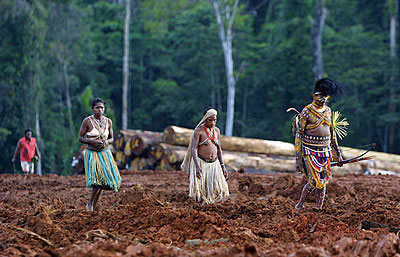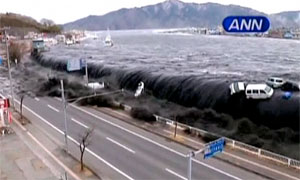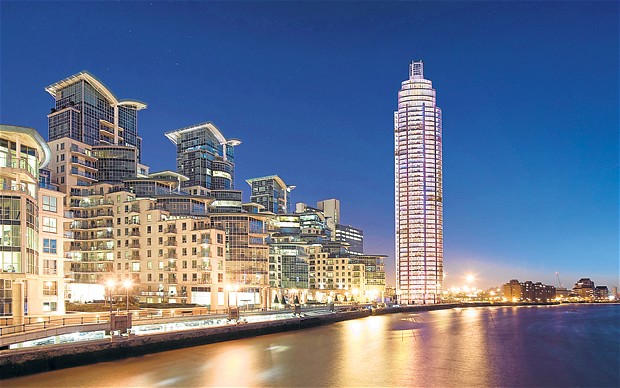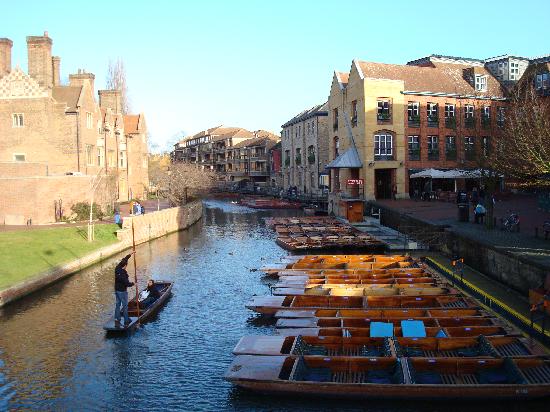462: Unsustainable Future
03-02-2013

PropertyInvesting.net team
Environmental Crisis: Beyond any doubt, man has created huge changes in the world in the last forty years. In 1½ generations, the population has doubled, the amount of rainforest has halved and the ice caps are a fraction of their former size. About half the reserves of conventional crude oil have been produced an the climate appears to have changed significantly with what looks like more severe storms and extreme weather conditions. The fish stocks have been decimated and sea beds in shallower wat ers ripped to pieces by beam trawlers. There has been large scale collapses of species across the globe.
ers ripped to pieces by beam trawlers. There has been large scale collapses of species across the globe.
Cities: Massive new cities have been built mainly in coastal regions. The Middle East desert populations have boomed off the back of cheap oil. The agricultural populations in the developing world have urbanised – moved and built cities looking for employment, wealth, opportunity and better education and healthcare.
Less War: Despite this gloom, there have been many bright-spots – namely the general decrease in the number and severity of wars. Sixty years ago millions died in many wars – now the numbers dying from military conflicts is far less. Technology with drones and tactical missiles along with intelligence system and more transparent news communications means its harder for atrocities to be covered up and more pressure is put on governments to stop mass destructions.
Food Plentiful: Despite the gigantic growth in the population, food is generally plentiful – people complain about the cost of food, but on the whole, there are less people starving in 2013 than there was decades ago even though the population has doubled. Crops yields have rise, farming efficiency has improved on the whole, and food distributions systems are better. Humanitarian food aid is more effective at getting through – recall the starving in Ethiopia in the 1980s – even though the population has exploded, East African people on the whole get fed although for most it is a hard life.
Is it Sustainable: The big question is – can the world continue to manage as the population rises by another 50% in the next 40 years. Will there be enough water, oil, food, wood, minerals, land and jobs for these people. Will the ecosystem survive this onslaught.
Peak Cheap Oil: Firstly, all the positive stories that “Peak Oil” is a myth miss the point. Peak Oil is the point when the production of oil starts to decline. What has happened in the last 7 years is that convention crude oil – that is the easy to extract low cost oil – has started to decline. This started in 2005. However, other forms of oil have been “invented” or “discovered” and have been added to the mix – thereby meaning “total liquids” hydrocarbon production has increase. These include:
· Oil shale – from tight shale deposits requiring hydraulic fraccing to produce at high cost
· Ethanol – the conversion of sugar cane and corn (normally used for food) into ethanol for fuel at high cost and environmental damage
· Deepwater Oil – oil extracted from water depths of >1000m – high cost and higher risk requiring plentiful high end technologies
· Natural gas Liquids – very light oil or condensate as a bi-product of natural gas production (as gas production has increase, so to have these liquids)
· Heavy Oil Sands – oil extracted from sands at the earth’s surface – put into a large burner-refinery and processed into heavy oil – mainly in Canada
Higher Costs: The problem with the five new entrants is they normally have a far higher cost, are far more energy intensive to extract, often have a larger environmental footprint and the calorific value of the oil is rather less than the conventional light sweet crude oils.
Running Harder: So we are fighter harder, spending more money and environmental resources on extracting these lower quality oils. Because the world’s surface area is so huge, 7 billion people don’t notice this. In fact, most people have never even seen an oil field. But its true to say the world is fighting harder, at higher cost and more risk to extract oil to keep the production continuing to rise – to feed China, India, developing countries expanding populations along with the thirst of the USA, Europe and other developed nations.
Technological Challenges in Risky Areas: For all those people that think Brazilian and Arctic oil will save the day – sorry, no change. Brazil needs all the oil it produces for its own needs – would be a net oil importer if it was not for its ethanol production from sugar cane. The deep water oil production is incredibly expensive – the state oil companies is struggling to increase oil production and costs have ballooned. It’s a massive technological and cost struggle with high risks. Ditto for Arctic oil – the drilling weather window is so small and costs so high its very doubtful many projects will ever become economic - even if the ice caps melt, there are still icebergs and environmentally very sensitive areas. Just don’t expect floods of oil ever to come from Arctic areas.
would be a net oil importer if it was not for its ethanol production from sugar cane. The deep water oil production is incredibly expensive – the state oil companies is struggling to increase oil production and costs have ballooned. It’s a massive technological and cost struggle with high risks. Ditto for Arctic oil – the drilling weather window is so small and costs so high its very doubtful many projects will ever become economic - even if the ice caps melt, there are still icebergs and environmentally very sensitive areas. Just don’t expect floods of oil ever to come from Arctic areas.
Forests Devastated: What is particularly awful is the stripping of rainforest – the land is then used for farming – sometimes by local villages that need to use it to grow food, but sometimes by large corporations to grow sugar, corn and other crops – for use in ethanol and other food manufacturing.
Morphing World: In the 1970s, people genuinely thought the world would run out of food and people would starve. Now most countries have obesity problems. Granted, there is still starvation in small pockets of the world, but chopping the rainforests down, using more machinery, improving yields with fertilizer and genetically modified crops, and more efficient use of water have improved crop yields and delayed big food shortages for now.
Severe Weather: The problem is – as the population continues to grow, people get more cars, use more oil, gas, electricity, eat more food (and meat which requires large amounts of grain), more CO2 is emitted, climates change further – at some point, without massive technological innovations, the whole things becomes unsustainable and the ecosystems start to collapse.
Energy Efficiency a Must: What is required in the first instance is far better energy conservation and improved efficiency. The world burns through a gigantic 86 million barrels of oil a day. Colossal. It’s probably possible to do a very similar amount of work with half the oil if it was used more efficiently. Just think about the efficiency of a petrol pick-up truck in the USA. They do 23 miles to the gallon at 55 miles an hour. These trucks should be doing at least 50 miles to the gallon with smaller and more powerful engines.
Wastage: In Dubai there is an indoor sky slope that burns 3500 barrels of oil a day – a third of amount of oil as Uganda uses each day with a population of 25 million – that’s about 8 million people’s worth of oil for one ski slope.
Rising Debts and Money Printing: As the population has expanded over the last 40 years, governments have expanded their debts, printed more money and created inflation. OECD countries, particularly USA, Japan, Italy, UK and France have borrowed money from China and other countries to pay for imports to keep their populations content and to create the illusion of real growth. Tomorrow’s money has been used to pay for today’s benefits. Eventually someone will need to “pay the piper”.
Currency Wars: In recent years and months, most countries have resorted to a currency war of debasement to try and boost exports and reduce imports. It started with the USA printing money to stimulate their economy – they exported inflation. Commodities prices rose – as did food prices. As poor people in desert nations struggled to pay for food when their food bills rose above 40% of earnings – they revolted – this was the underlying cause of the so called “Arab Spring”. This was an unintended consequence of the money printing binge post 2008 financial crisis. But then the UK joined in with massive money printing, the European chipped in, in a smaller way, China stimulated – and now the Japanese have joined in – in a big way. Brazil has also joined the fray. So please be under no illusion that this will all lead to higher inflation. Prices will rise sharply. It will be like the late 1970s again.
Debasement: If you look back at the US dollar, it has lost 98% of its value since 1918. Yes, its worth just 2% of the value of in 1918. Its devaluation is now accelerating. Eventually its value will turn to pretty close to zero – before a reset. There is no currency known to man that has not eventually gone to zero. So be careful holding “currency” or printed paper. The only real money is gold and silver – which have retained their value for hundreds of years. If currency debasement accelerates and inflation accelerates – the only sure way of retain wealth is to own physical assets like gold and silver. Oil is another good proxy. Houses are physical assets as well. In such times, to hedge against inflation, you need to own any physical asset like: gold, silver, oil, land, property, food, artwork.
Japan: Government debt of 230% of GDP. Its been a huge struggle getting over the effects of the tsunami. The last five of 54 nuclear plants is about to be shut down – they will take years to re-open - many will never re-open. Meanwhile Japan is now importing all its oil,  gas, coal fuels for the generation of electricity. Savings rates have dropped from 20% to about 6% in the last few years. The savings are now being drawn down as waves of people retire. The trade surplus has disappeared. Japan has been the second biggest economy in the world - now overtaken by China. They cannot afford to buy US debt anymore. The Japanese are a very insular proud society – they have been hit by earthquakes, tsunami and the nuclear plant disaster – now the government has started a giant money printing programme. The weaker currency is just a way of attempting to destroy the massive debt – but it will eventually end in economic destruction on a grand scale. The aging Japanese economy is set for a large fall after 25 years of low growth and deflation. Aging baby-boomer and a low fertility rate has finally caught up with Japan – expect the Yen value to crash.
gas, coal fuels for the generation of electricity. Savings rates have dropped from 20% to about 6% in the last few years. The savings are now being drawn down as waves of people retire. The trade surplus has disappeared. Japan has been the second biggest economy in the world - now overtaken by China. They cannot afford to buy US debt anymore. The Japanese are a very insular proud society – they have been hit by earthquakes, tsunami and the nuclear plant disaster – now the government has started a giant money printing programme. The weaker currency is just a way of attempting to destroy the massive debt – but it will eventually end in economic destruction on a grand scale. The aging Japanese economy is set for a large fall after 25 years of low growth and deflation. Aging baby-boomer and a low fertility rate has finally caught up with Japan – expect the Yen value to crash.
Race to the Bottom: Since 1971 when the US went off the gold standard, there has been an exponential increase in debt levels in the USA and western developed nations, accelerating in 2008 after the beginning of the financial crisis. All major economies are printing huge amounts of electronic currency to keep their currency values low and stimulate exports, inflation and phantom growth wh ilst reducing (or monetising) the debt in real terms. This is important – they are defaulting on their bonds by printing money – deflating the value of the debt away. This is a dangerous economic environment of fiat currency, debasement, increasing inflation and gradual default – with countries growing increasingly frustrated with the extent of the debasement (call it stealth default). This eventually leads to panic as inflation rises – and we believe the price of gold will eventually have to account for all this phantom currency – gold prices will go ballistic. It’s just a question of when. So don’t be put off by these stories by investment banks that the end of the gold bull-run is on us – it’s not, it’s only the beginning, because on our eyes, undoubtedly things will get worse – before a complete re-set (either very high inflation, default or a combination of both). The banks are trying to shake out the small players from the bullion markets to give one last opportunity for Central banks and big investors and banks to buy gold on the cheap. But its price will eventually go stratospheric. Don’t be put off.
ilst reducing (or monetising) the debt in real terms. This is important – they are defaulting on their bonds by printing money – deflating the value of the debt away. This is a dangerous economic environment of fiat currency, debasement, increasing inflation and gradual default – with countries growing increasingly frustrated with the extent of the debasement (call it stealth default). This eventually leads to panic as inflation rises – and we believe the price of gold will eventually have to account for all this phantom currency – gold prices will go ballistic. It’s just a question of when. So don’t be put off by these stories by investment banks that the end of the gold bull-run is on us – it’s not, it’s only the beginning, because on our eyes, undoubtedly things will get worse – before a complete re-set (either very high inflation, default or a combination of both). The banks are trying to shake out the small players from the bullion markets to give one last opportunity for Central banks and big investors and banks to buy gold on the cheap. But its price will eventually go stratospheric. Don’t be put off.
UK Crisis: The UK finances are even worse than the US finances. At least the USA has increasing production of gas and oil – meanwhile the UK oil and gas production has collapsed in recent years prompted by three tax hikes in the North Sea, the last in March 2011 helped precipitate a 23% oil and gas production collapse in the 12 month period afterwards. Now the Chancellor is getting less tax than if he had not put the tax up – he “shot the goose that lay the golden egg”. Some tax breaks in the last few weeks have encouraged further investment but a steady decline in oil and gas production looks highly likely even with this extra investment.
Options: So what can a UK investor so to attempt to achieve high returns in this turbulent period of no GDP growth and high inflation.
Gold: Despite rec ent news to the contrary, we believe gold prices will eventually sky-rocket as inflation gets out of control and the bond markets crash. Normally at the end of a bond market cycle, the gold accounts for all the fiat currency. If it truly did this time at the current US debt levels – all the dollar derivatives in the world, gold would be about $64,000 an ounce. Let’s be conservative and say – that one day at the end of this cycle – between now and 2018 – gold prices will rise to between $3000 and $6500/ounce. The current price of $1580/ounce looks like a bargain.
ent news to the contrary, we believe gold prices will eventually sky-rocket as inflation gets out of control and the bond markets crash. Normally at the end of a bond market cycle, the gold accounts for all the fiat currency. If it truly did this time at the current US debt levels – all the dollar derivatives in the world, gold would be about $64,000 an ounce. Let’s be conservative and say – that one day at the end of this cycle – between now and 2018 – gold prices will rise to between $3000 and $6500/ounce. The current price of $1580/ounce looks like a bargain.
Silver: if ever something looks incredibly good value – it is silver at $28/ounce. Silver has a huge amount of industrial usages – electronic, medical-sterile, mobile phones, water filters – there is less silver than gold on the earth’s surface now. Silver is a bi-product of other mining. Other mining is in “go slow mode” because of rising costs. Silver reached $50/ounce in 1980. 33 years later, its $28/ounce. Name one other thing that is cheaper today then in 1980 – silver is the only one. In dollar printing inflation adjusted terms – the $50/ounce peak is equivalent to around $500/ounce. If panic set in, silver could easily rise to $150/ounce from the current $28/ounce. You wont regret being silver bullion – even if it’s just ten coins. There is only enough silver on this earth’s surface for 0.07 ounce/person – worth a total of $2. Yes, $2 worth of silver per person. Consider how important silver is for electronics – it could easily increase five-fold in price.
Tobacco: If you cannot think of anything else, tobacco company equity – could be a good investment. These reason is that the dividend is a gigantic 7% and as the world’s population increases, more cigarettes will be sold. It’s one of the safest investment during economically hard times because people normally continue to smoke – it’s about the last thing people give up. If hyper-inflation kicks in, cigarette prices will skyrocket, tobacco companies will survive and so will equity in these companies. They survive world wars and depression. People will always smoke. It’s one of the best pensions around. If you have £1,000,000 in cash, and buy tobacco stock, you will get £70,000 a year in dividends. Better than nothing from a savings account – when your cash will be destroyed by inflation.
London Property. Particularly good for UK based investors who expect to see rising inflation, debasement of the UK currency, rising rental prices and erosion of mortgage debt over time – a hedge against inflation:![]()
Shoreditch-Whitechapel-London: Just NE of the City of London, also close to Canary Wharf and only ten minutes tube to the West End. Close proximity to City Airport with reasonable links to Heathrow and Stansted Airports. At the “Silicon Roundabout” with booming high tech-media and start-up businesses. Young multi-cultural population. Trendy with city slickers, artists, media and young professionals. Expanding population. Close to St Pancras and Stratford – spin-off from Westfield and Olympic village regeneration area. Strong rental demand. Prices have already risen sharply over the last 14 years, but properly have some way to go as further foreign money comes in, and the edges of City high priced areas expand outwards. Suggested type of property: 2 double bedroom mansion flat (not ground floor or basement), in quite road close to Old Street station. The new Crossrail stations come through at Whitechapel and Liverpool Street. A few minutes walk to these two stations could be particularly lucrative.
2. Farringdon - London: On the western fringe of the City of London, ju st to the east of mid-Town, and about 1½ miles east of the West End, fairly close to Canary Wharf and on the fringe of Mid-Town. Massive boost will be Crossrail coming through in 2017 with a brand new station. Strategically positioned to go north-south (Gatwick-Luton) and East-West (Heathrow, Stansted, City Airport). Close to shops, restaurants, high paid jobs of all kinds, theatre, tourist attractions. A busy rich city slicker lazy person’s ideal location right in the middle of all the action. Prices are already high, but Crossrail should boost even further. If a financial meltdown takes place, at least wealthy international people will find this a safe haven and there are many types of jobs in Mid-Town (legal) and West End (retail, hedge-fund etc). Suggested types of property: 2 double bedroom mansion flat (not ground floor or basement) preferably with balcony, ex-council flat if you can find a good one - on quite road close to Farringdon Station.
st to the east of mid-Town, and about 1½ miles east of the West End, fairly close to Canary Wharf and on the fringe of Mid-Town. Massive boost will be Crossrail coming through in 2017 with a brand new station. Strategically positioned to go north-south (Gatwick-Luton) and East-West (Heathrow, Stansted, City Airport). Close to shops, restaurants, high paid jobs of all kinds, theatre, tourist attractions. A busy rich city slicker lazy person’s ideal location right in the middle of all the action. Prices are already high, but Crossrail should boost even further. If a financial meltdown takes place, at least wealthy international people will find this a safe haven and there are many types of jobs in Mid-Town (legal) and West End (retail, hedge-fund etc). Suggested types of property: 2 double bedroom mansion flat (not ground floor or basement) preferably with balcony, ex-council flat if you can find a good one - on quite road close to Farringdon Station.
3. Ealing: This subsurb is reasonably expensive already – famed for its Japanese school (expats) and reasonably leafy Victoriana. A big new Crossrail station is planned at Ealing Broadway meaning city financiers will be able to get into the City in 17 mins (instead of the current 40 mins). We expect this to add 20% to house prices in the long run. Best area is just to the north of Broadway in the conservation area and close to the university and old Ealing Studios.
3. Cambridge and St Neots: Booming population. Booming jobs growth. Hig h-tech and new ventures, science parks, one of the most robust areas for employment in the UK. Cambridge is a beautiful University City – visiting Cambridge is like being in a privileged bubble so it’s little wonder why so many graduates stay in Cambridge and join high-tech and science companies and research and development entities. House prices are already high, but things look good long term. Suggested property is a 2-3 bedroom terrace house close to the city centre that can be rented to students, lecturers, employees of science companies and wealthy individuals – possibly retirees. St Neots is a little cheaper, with lots of potential as more businesses move into the area. On the A14 and M11 junction hence good road connections. In both places, make sure you avoid flood prone properties. Buy only in quite streets, in Victorian neighbourhoods (not new builds or council housing estates).
h-tech and new ventures, science parks, one of the most robust areas for employment in the UK. Cambridge is a beautiful University City – visiting Cambridge is like being in a privileged bubble so it’s little wonder why so many graduates stay in Cambridge and join high-tech and science companies and research and development entities. House prices are already high, but things look good long term. Suggested property is a 2-3 bedroom terrace house close to the city centre that can be rented to students, lecturers, employees of science companies and wealthy individuals – possibly retirees. St Neots is a little cheaper, with lots of potential as more businesses move into the area. On the A14 and M11 junction hence good road connections. In both places, make sure you avoid flood prone properties. Buy only in quite streets, in Victorian neighbourhoods (not new builds or council housing estates).
4. Brockley SE4 – London: The London housing crisis means that any property central to London with good communications will likely see house prices and rental prices rise in the longer term. It’s important though to be careful not to buy in areas that could go “down-hill” rapidly if riots break-out, unemployment worsens or the security situation deteriorates. Brockley is a reasonably quiet neighbourhood with a new East London Rail Line station that provides fast access now to Shoreditch-The City. The jobs growth is in the City and Canary Wharf along the rail line. Property prices are still fairly low having been depressed after the financial crisis in 2008. Long term, Victorian terraces and flats should see prices robust and rising, particularly if they are close to the station, in quite streets and close to parks or green spaces. “Brockley Village” will become more trendy as richer young professionals move in. Was a very depressed suburb back in the 1980s, and started gentrifying in the mid 1990s. Still a long way to go. Suggested properties – Victorian 3-4 bedroom terrace with south or west facing garden, 1 or 2 double bedroom flats (if on ground floor, should have access to a garden-patio, if on the first floor, this is also okay since security is better).

All five of these investment picks have large amounts of new jobs being created - hence rental demand from young professional people for reasonably high quality property would be very high indeed, also looking to the future.
We hope this special report has help give you insights and ideas for your investment portfolio. If you have any questions, please contact us on enquiries@propertyinvesting.net

